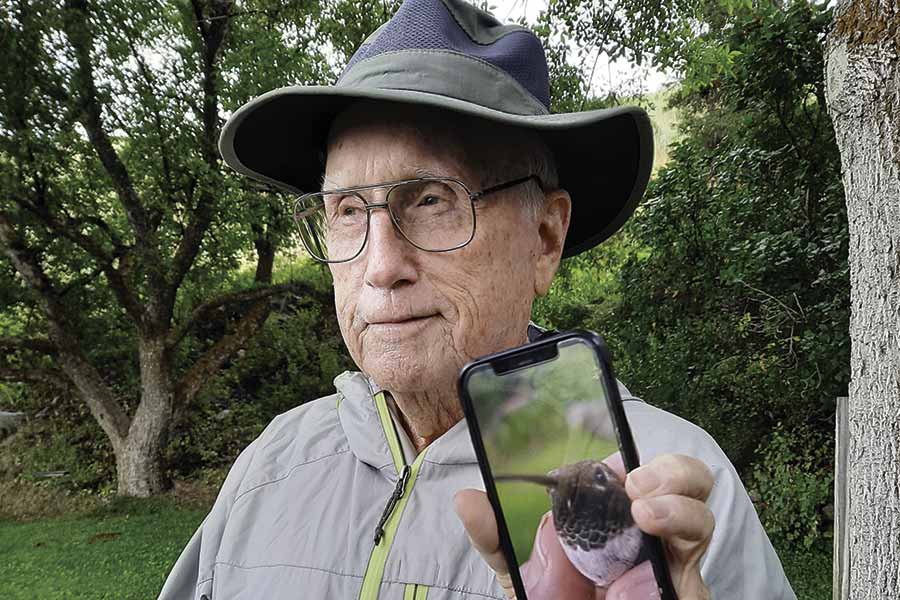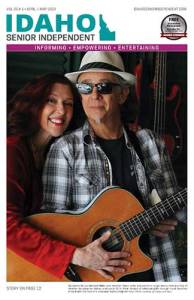Idaho Master Bird Bander, Fred Bassett, Helps Unravel Hummingbirds’ Astounding Lives
By Dianna Troyer
Idaho master bird bander Fred Bassett has been helping unravel the mysteries of hummingbirds and their remarkable endurance for more than two decades.
“I never get tired of doing this,” he recently told a small, appreciative audience who watched him weigh and measure the length of a male Black-chinned hummingbird at a rural home near Inkom in southeastern Idaho.
“It’s not like doing this is any kind of hardship,” he said before gently placing a tiny lightweight metal band with identification numbers above its foot.
Since 1997, Bassett has made it his mission to band hummingbirds, teach others to do it, and to educate onlookers wherever he travels. He became enthralled with them after friends taught him how to band them.
In 17 states, he has banded more than 35,000 hummingbirds at 1,400 locations. Unraveling information about their secretive lives, he has documented population trends and impressive migration distances while educating onlookers about the colorful charismatic aviators, the only birds able to fly backwards.
To share insights about them, he founded hummingbirdresearch.net and posts videos, Hummingbirds with Fred Bassett, on YouTube, even showing hummingbirds sipping at feeders during winter.
From late spring through autumn, he lives in Boise and travels primarily throughout Idaho, where more than four species abound.
“You’re the lucky ones out here in the West because you routinely see Broad-tailed, Calliope, Black-chinned, and Rufous. Back East, the Ruby-throated hummingbird is dominant.”
Bassett, 77, a certified master bird bander and retired Air Force pilot, is based in his home state of Alabama during winter. Only 125 such master banding permits are issued by the Bird Banding Laboratory through the U.S. Geological Survey.
The high energy birds become subdued as he gently handles them.
“You can feel their heartbeat – about 600 beats a minute when they’re calm and 1,200 beats when they’re exerting themselves,” he said, gentling depositing a bird in the palm of an awestruck onlooker. “If your heart does that, you’d be in a heap o’ trouble. Stay just like that; we’ll check back with you in an hour or so and see how you’re doin’.”
The female Broad-tailed hummingbird seems to be napping, her iridescent emerald plumage hypnotizing nearby spectators. Eventually, she zooms away.
Remarkable appetite and lives
At this particular home in mid-summer, the tiny birds with voracious appetites gobble 3 gallons of sugar water daily at 10 one-quarter feeders hung throughout the yard. Bassett bands about 70 to 80 daily, with several returning.
“This one likes me so much, she’s back again – in the same day,” he said. “I get more returns here than anywhere else, about 25 to 35 percent. They must like the food. If you want to put up a feeder, remember it’s one part sugar to 4 parts water and no honey or red food coloring.”
His record for banding at the Inkom location is 200 birds in four hours. To satisfy the hummers’ seemingly insatiable appetites, the couple buys 250 pounds of sugar from spring to fall. Their reward is hosting 100 to 200 birds every evening and inviting friends to come, sit, and be at peace.
The last two weeks of July is the busiest with babies fledging. Twice a day, the 10 one-quart feeders are filled.
Bassett tells a scribe each bird’s species, gender, length, and weight and band number. The information will be entered into the Bird Banding Laboratory’s database. Generally, North American hummers weigh 0.1 to 0.2 ounces and are 3 to 4 inches long, with a wingspan of about 3 to 4 inches.
As he bands, Bassett describes their remarkable lives. After building a nest of soft plant fibers, twigs and fresh spider webs, a female often shingles the exterior with tiny bits of leaves. Her two eggs, each about the size of a Tic Tac, incubate for 15 to 18 days. After hatching, they fly away 18 to 28 days later. Birds tend to return to their birthplace.
The most agile bird, hummingbirds’ flight maneuvers are mind-boggling as their wings move in a figure-eight pattern at more than 50 times a second, creating the characteristic humming sound.
“Their shoulders rotate 360 degrees, so they can hover and fly any direction—even backwards,” he said. “They make pilots jealous.”
For their size, they are speedy fliers, zooming up to 37 mph and up to 60 mph in courtship dives.
“Watch that Black-chinned male there,” Bassett said, pointing. “See his shuttle maneuver—back and forth, back and forth. It’s his way of showing off, so a female sees how handsome he is.”
Their stamina is impressive. The Ruby-throated often doubles its weight and migrates alone, flying nonstop 600 miles across the Gulf of Mexico in 18 to 24 hours, depending on the weather. To some, it is inconceivable.
“People tell me that’s impossible,” he said. “I tell them they can believe whatever they want, but that’s what the research shows from our banding.”
About 80 percent die in the first year, while their average age is three to five years. Yet some record-setting birds defy those odds, according to the website hummingbirdresearch.net.
Flying feats
A female Black-chinned hummingbird Bassett banded near Inkom in June 2008 returned in July 2019, making it the second-oldest hummingbird ever recaptured. It was at least 13 years and 1-month-old.
A female Anna’s hummingbird he banded 10 miles north of Council, Idaho on May 30, 2015 was the first proof of that species nesting in Idaho.
A male Ruby-throated hummingbird he banded January 24, 2014 in Lakeland, Florida was found May 27, 2018 in Utopia, New Brunswick, Canada, a trek of 1,700 miles. It was the first wintering Ruby-throated found on its breeding grounds.
A female Rufous set the record of 3,500 miles for banding and recapture – from Tallahassee, Florida to Chenga Bay, Alaska. In Florida, Fred Dietrich banded her on January 13, 2010. Five months later, on June 28, 2010, she was found by fellow bander Kate McLaughlin.
Future discoveries
Eventually, new technology may supplement the bands, Bassett said. A lightweight battery-powered tracking device is being developed for the birds to wear and would enable researchers to pinpoint their daily movements and migration routes.
“Whenever that’s accomplished, we’ll have a heap of new insights and learn just how much we didn’t know.”
More information is at Hummingbirds with Fred Bassett, Summer, and Winter, on YouTube and at hummingbirdresearch.net. ISI










